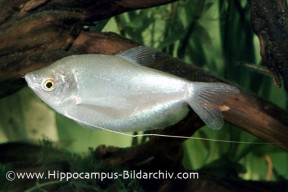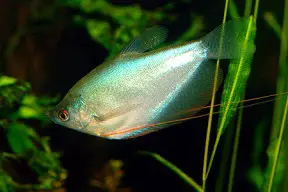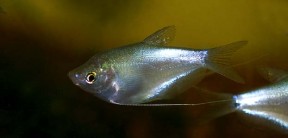Trichopodus microlepis
Moonlight Gourami
Classification
Osphronemidae. Subfamily: Luciocephalinae
Distribution
Occurs naturally in Vietnam, Cambodia and Thailand. There are also feral populations in Singapore and Colombia. Wild fish are rare in the hobby these days, with the vast majority of the ones on sale being mass-produced in the Far East and Eastern Europe.
Habitat
Inhabits lowland ponds, bogs and swamps, especially where aquatic and marginal vegetation grows densely.
Maximum Standard Length
6″ (15cm)
Aquarium SizeTop ↑
36″ x 12″ x 12″ (90x30x30cm)
Maintenance
A planted setup with open areas for swimming and slow water flow suits this species.
Water Conditions
Temperature: 77-86°F (25-30°C)
pH: 6.0-7.5
Hardness: 2-25 dH
Diet
Omnivorous. Will take most commercially-prepared foods but supplement with frozen and live foods.
Behaviour and CompatibilityTop ↑
Do not keep with fish so small as to be seen as food, or that are too vigorous for these skittish fish. Ideal tankmates include other Trichogaster, Colisa, Botia, Corydoras, Barbs, Angelfish and loricariids. Males may become territorial with other males and gouramis.
Sexual Dimorphism
The male has orange or red pelvic fins, while the femaleñ¢â‚¬â„¢s are yellow.
Reproduction
Not easy. Bubblenester. If you wish to breed T. microlepis provide the pair with their own tank, which should be densley planted and contain floating plants. Decrease the water level to 6-8 inches and slowly raise the temperature to 85F. Feed the pair lots of live food. When he is ready the male will construct a loose bubblenest amongst surface vegetation. The pair will position themselves under the nest and adopt the typical anbantoid spawning embrace. Spawning may last up to 2 hours, and up to 2000 eggs may be released. At this stage it is advisable to remove the female. Fry hatch in 1-2 days, with the fry becoming free swimming 2 days later. The male can now also be removed. The fry must be fed very small foods such as infusoria 3-4 times daily for the first fortnight, at which point they will start taking newly hatched brine shrimp and powdered flake food. The fry are very sensitive to changes in water chemistry. It is recommended to change no water until the fry measure 1/2″ or so.
NotesTop ↑
T. microlepis is not as colourful as some other gouramis but can make a striking addition to the community tank. The modified ventral fins are considerably longer than in other gourami species. It is often used as a food fish in its native countries.




